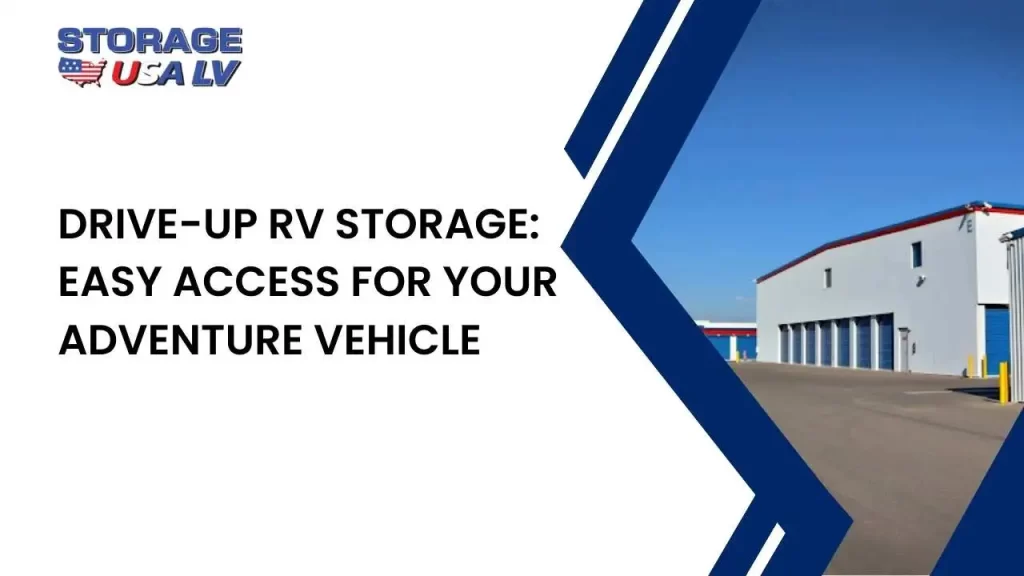
Storing your RV doesn’t have to be a hassle. With drive-up RV storage, you gain the convenience and accessibility you need to keep your adventure vehicle ready for the road at any time. Whether you’re an experienced RV owner or a newbie, understanding the ins and outs of drive-up storage can make your life a lot easier. So, what exactly is drive-up RV storage, and why should you consider it? Let’s dive in!
What is Drive-Up RV Storage?
Drive-up RV storage is a type of storage facility where you can park your RV directly in front of your storage unit. Unlike traditional storage units that may require you to carry your belongings over a distance, drive-up storage allows you to access your RV easily. This means you can load and unload your vehicle with minimal effort, saving you time and energy.
Why Drive-Up Access is a Game-Changer
Imagine planning a last-minute trip, only to be delayed by the cumbersome process of retrieving your RV from a traditional storage unit. Drive-up access eliminates this issue by providing direct, hassle-free entry to your RV. It’s like having your vehicle parked at home, but with the added security and protection of a storage facility.
The Benefits of Drive-Up RV Storage
Convenient Access Anytime: One of the most significant advantages of drive-up RV storage is the convenience. You can access your RV whenever you need it, without worrying about navigating through a large storage facility. Whether you’re prepping for a weekend getaway or returning from a long trip, the ease of access makes a world of difference.
Stress-Free Loading and Unloading: Gone are the days of lugging heavy gear across parking lots. With drive-up RV storage, you can pull up directly to your unit and start loading or unloading your vehicle. This feature is especially beneficial for those who frequently use their RVs and need to pack or unpack quickly.
Enhanced Security Features: Drive-up RV storage facilities often come with robust security features, including gated access, surveillance cameras, and on-site staff. These measures ensure that your RV is safe from theft or vandalism, giving you peace of mind when you’re away.
Types of RV Storage Options
There are three types of RV storage options: indoor, outdoor, and covered, each offering different levels of protection.
Indoor vs. Outdoor Storage
When it comes to storing your RV, you generally have two options: indoor and outdoor storage. Indoor storage provides protection from the elements, while outdoor storage is often more affordable. Drive-up storage is available in both indoor and outdoor settings, allowing you to choose based on your needs and budget.
Covered Storage Solutions
Covered storage offers a middle ground between indoor and outdoor storage. Your RV is protected from direct sunlight, rain, and snow, yet it’s not completely enclosed. This option is ideal for those looking for some level of protection without the higher cost of indoor storage.
Climate-Controlled Units
For those who want the ultimate protection for their RV, climate-controlled units are the way to go. These units maintain a stable temperature and humidity level, protecting your RV from extreme weather conditions and potential damage.
Finding the Right Drive-Up RV Storage Facility
Choosing the right drive-up RV storage facility involves considering location, amenities, security features, and overall cost.
Location Considerations
The location of your storage facility is crucial. Ideally, it should be close to your home or along your usual travel routes. This makes it easier to pick up your RV when you’re ready to hit the road. Additionally, consider the neighborhood’s safety and the facility’s accessibility.
Facility Amenities to Look For
Not all storage facilities are created equal. When choosing a drive-up RV storage facility, look for amenities such as 24/7 access, wide driveways, and dump stations. These features can make your storage experience more convenient and comfortable.
Cost vs. Value
While it might be tempting to go for the cheapest option, consider the value you’re getting for your money. A slightly more expensive facility with better security, amenities, and customer service might be worth the investment in the long run.
How to Prepare Your RV for Storage
To prepare your RV for storage, clean it thoroughly, perform maintenance, cover it properly, and winterize if necessary.
Cleaning and Maintenance
Before storing your RV, it’s essential to clean both the interior and exterior. This prevents mold, mildew, and pests from making a home in your vehicle. Don’t forget to perform routine maintenance, such as checking the tires and battery.
Properly Covering Your RV
If you’re storing your RV outdoors or in a covered storage unit, using a high-quality cover is a must. It protects your vehicle from dust, dirt, and UV damage, keeping it in top condition.
Winterizing Your RV
If you plan to store your RV during the winter months, winterizing is crucial. This process involves draining the water systems, adding antifreeze, and sealing any openings to prevent freezing damage.
Drive-Up Storage Tips for First-Time RV Owners
First-time RV owners should navigate the facility, organize storage space, and conduct regular maintenance check-ins for optimal storage.
Navigating the Facility with Ease
As a first-time RV owner, navigating a storage facility can be daunting. Take your time to familiarize yourself with the layout and practice maneuvering your RV within the space. This will help you feel more confident when accessing your vehicle.
Organizing Your Storage Space
Keeping your storage unit organized is key to a smooth experience. Use shelving, bins, and labels to store your RV accessories and gear. This way, you’ll know exactly where everything is when you need it.
Regular Check-Ins and Maintenance
Even while your RV is in storage, regular check-ins are essential. Inspect your vehicle for any signs of wear or damage, and perform maintenance tasks as needed. This proactive approach ensures your RV is always ready for your next adventure.
Common Mistakes to Avoid with RV Storage
Avoid overpacking, neglecting maintenance, and ignoring security measures when storing your RV to prevent costly issues.
Overpacking the Storage Unit: It’s easy to overestimate how much you can store in your unit. Avoid cramming too much gear into the space, as this can lead to damage or make it difficult to access your RV. Keep it organized and only store what’s necessary.
Ignoring Routine Maintenance: Just because your RV is in storage doesn’t mean it’s maintenance-free. Neglecting routine tasks like checking tire pressure, battery health, and fluid levels can lead to costly repairs down the road.
Neglecting Security Measures: While storage facilities have security features, it’s important to take additional precautions. Use wheel locks, alarm systems, and remove any valuables from your RV to reduce the risk of theft.
Conclusion
Drive-up RV storage offers unparalleled convenience and security for your adventure vehicle. Whether you’re a seasoned RV owner or just starting, understanding how to choose the right facility and prepare your RV for storage is essential. With the right approach, you can ensure your RV is always ready for your next road trip, giving you more time to focus on the journey ahead.
Frequently Asked Questions
Drive-up RV storage allows you to park directly in front of your storage unit, making it easier to access your vehicle. Regular storage may require you to carry your belongings over a distance, which can be less convenient.
Most drive-up RV storage facilities offer robust security features such as gated access, surveillance cameras, and on-site staff, ensuring your RV is well-protected.
Yes, many drive-up storage facilities offer 24/7 access, allowing you to retrieve your RV whenever you need it.
To prepare your RV for long-term storage, clean it thoroughly, perform routine maintenance, and use a high-quality cover to protect it from the elements. Additionally, winterize your RV if storing it during cold months.
You can find a drive-up RV storage facility near you by searching online, reading customer reviews, and visiting local storage facilities to compare options.

